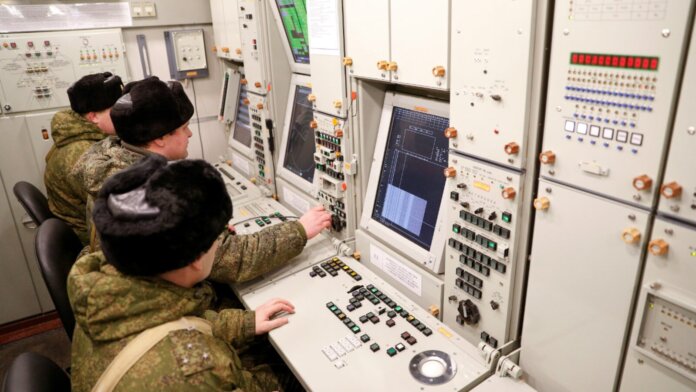
Armada’s electronic warfare webpage and monthly newsletter is running a series of articles on the components and concept of operations of Russia’s strategic Integrated Air Defence System (IADS).
Recent articles have examined the ground-based air surveillance radars used to detect, identify and track air targets. A key part of the IADS are the Tactical Datalinks (TDLs) sharing tactical information with effectors. Russian language documents seen by Armada reveal how the Russian Air and Space Force (RASF) uses TDLs.
TCS-2M
It appears that the TCS-2M remains the standard TDL in service with the RASF. Russian sources say the TCS-2M moves tactical data between aircraft and Ground-Controlled Interception (GCI) centres and vice versa. The RASF calls GCI centres Aviation Guidance Points (ACPs). ACPs and truck-based mobile air Command and Control (C2) stations use VIP-117M3 C2 terminals. These terminals take primary and secondary (identification friend or foe) data from local radars. This radar data is fused with imagery provided by local air traffic control radars enriching the recognised air picture. Track data is then shared with fighters and ground-based air defence units under the ACP or mobile centre’s command. This tactical information is fed into standard RASF surface-to-air/air-to-surface radios. The tactical information will be converted by software in the radios into the appropriate TDL protocol and transmitted. The VIP-117M3 will receive further scrutiny in future Russian IADS Redux articles.
The TCS-2M may also carry data between fighters and the RASF’s A-50U Mainstay airborne early warning and control aircraft. The documents continue that up to 20 subscribers can be hosted on an individual TCS-2M network. Data is carried at a rate of 1.024 kilobits-per-second/kbps across High Frequency (three megahertz/MHz to 30MHz) and Very High Frequency (30MHz to 300MHz) links. Aircraft terminals handling TCS-2M traffic include the S-103, S-108, S-111N, S-603, Planet and Type-1B/2. These terminals are used on Su-34 (NATO reporting name Fullback) and Su-35 (NATO reporting name Flank-E) warplanes.
OSNOD
The TCS-2M datalink is being replaced by the OSNOD system. Russian sources say this heralds a step change in capability. OSNOD expands the TDL subscriber network beyond the RASF with OSNOD users in Russian naval and land forces. OSNOD traffic can also move across Russian military Satellite Communications (SATCOM) unlike TCS-2M data. Like the TCS-2M, OSNOD will use HF and VHF links, alongside SATCOM, and also ultra-high frequency (300MHz to three gigahertz) channels. The documents stipulate potential data rates from 2.4kbps up to 3.4 megabits-per-second. This will be largely contingent on the links used. For example, HF will provide slower rates with SATCOM boasting faster ones. SATCOM terminals handling OSNOD traffic include 4RT-S, Baget-K, Kulon-V, Lvin and Legend. These terminals use frequencies of 300MHz to 400MHz and four to six gigahertz. Baget-K terminals are installed on RASF Tu-160/M2 (NATO reporting name Blackjack) strategic bombers. They probably handle strategic nuclear weapons C2 data. Alongside conventional voice and data communications, Russian documents say that OSNOD provides video conferencing and voice-over-internet-protocol telephony.
Challenges
The exact status of OSNOD is unknown but there is speculation it has already entered limited service with the Su-57 (NATO reporting name Frelon) combat aircraft. OSNOD is certainly an ambitious programme. Promised bandwidths of up to 3.4mbps demand robust, wideband links capable of handling such traffic. Russian Army experience in Ukraine has raised questions on the quality of Russian military radio technology. Data rates of between 30kbps and 120kbps, comparable to those of the North Atlantic Treaty Organisation’s Link-16 air operations TDL, may be sufficient for RASF tactical air C2 requirements. These fall within OSNOD’s reported capabilities. Nonetheless, they are a step change from the TCS-2M data rates and the question must be asked as to whether existing RASF communications systems can support these?
It also remains unknown whether the RASF has deployed OSNOD to support Russia’s ongoing war in Ukraine. It is possible that the force is using a mix of TCS-2M and OSNOD. For example, the latter maybe used by Su-57s deployed to the Ukraine theatre. This raises questions as to the extent these two protocols can work together. To this end, is the RASF using any form of link translation to move traffic between the two protocols? Moreover, combat operations in Ukraine will almost certainly have slowed OSNOD’s implementation as C2 infrastructure carrying OSNOD will be needed in theatre. This could slow the pace at which existing C2 systems can be upgraded to use the new protocol. We also need to talk about sanctions. The United States, the European Union and allied nations have enacted restrictions covering Russia’s access to microelectronics. Will this frustrate the RASF’s ability to realise OSNOD?
Stay tuned for more analysis on Russia’s strategic air defence capabilities in the next instalment of our Russian IADS Redux series.

by Dr. Thomas Withington
Read our other Russian IADS Redux articles:
- Russian IADS Redux Part-1: Resonating with Resonance
- Russian IADS Redux Part-2: Hilltop View
- Russian IADS Redux Part-3: Strategic Skywatchers
- Russian IADS Redux Part-5: Reset Password?













